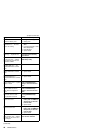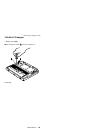
LCD-related symptoms
Important
The TFT LCD for the notebook computer contains
many thin-film transistors (TFTs). A small number of
dots that are missing, discolored, or always lighted
is characteristic of TFT LCD technology, but
excessive pixel problems can cause viewing
concerns. The LCD should be replaced if the
number of missing, discolored, or lighted dots in any
background is:
v SVGA: 5 or more bright dots, 5 or more dark
dots, or a total of 9 or more bright and dark dots.
v XGA: 8 or more bright dots, 8 or more dark dots,
or a total of 9 or more bright and dark dots.
Note: Bright dots means pixel is always on (white
or color.) Dark dots means pixel is always off
(black color.)
Symptom or error FRU or action, in sequence
No beep, power-on indicator
on, and a blank LCD during
POST.
System board.
v LCD backlight not working.
v LCD too dark.
v LCD brightness cannot be
adjusted.
v LCD contrast cannot be
adjusted.
1. Reseat the LCD
connectors.
2. LCD assembly.
3. System board.
v LCD screen unreadable.
v Characters missing pixels.
v Screen abnormal.
v Wrong color displayed.
1. See important note for
“LCD-related symptoms”.
2. Reseat all LCD connectors.
3. LCD assembly.
4. System board.
Horizontal or vertical lines
displayed on LCD.
LCD assembly.
Intermittent problems
Intermittent system hang problems can be due to a variety
of causes that have nothing to do with a hardware defect,
such as cosmic radiation, electrostatic discharge, or
software errors. FRU replacement should be considered
only when a problem recurs.
When analyzing an intermittent problem, do the following:
1. Run the diagnostic test for the system board in loop
mode at least 10 times.
2. If no error is detected, do not replace any FRUs.
Symptom-to-FRU index
46 ThinkPad A21e


















